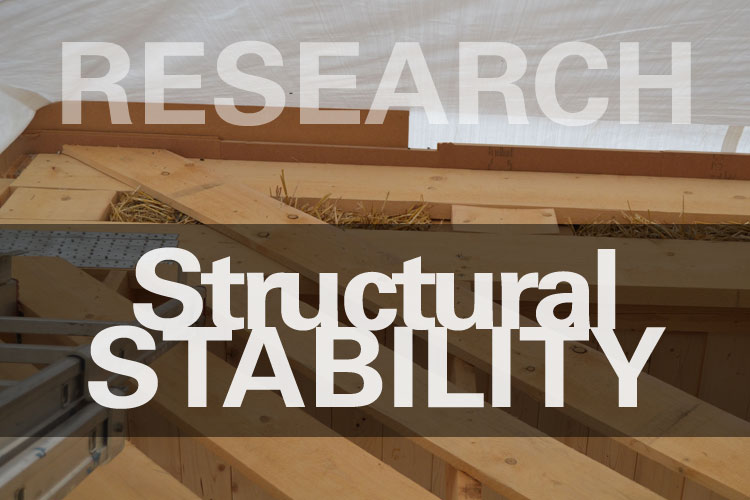In this article, the planning, execution, and evaluation of experimental tests on horizontal load transfer in walls made of highly compacted straw bales are presented. The investigations aim to better understand the load-deformation behaviour of straw walls loaded in their plane. The assessment of the results is done by using classical mechanical and modern optical measurement methods. To study the frictional bond between the straw bale layers and the influence of vertical loads, the use of mechanical shear connectors is deliber-ately avoided.
Results: The tests carried out contribute to a better understanding of the mechanisms of horizontal load transfer in straw bale walls without additional reinforcement by mechanical bonding agents or plaster layers. The results show that the flow of forces in loosely stacked straw bales is primarily ensured by friction in the horizontal joints. Irreversible deformations occur, whose amount and distribution over the wall height are strongly influenced by vertical imposed loads and the associated normal stresses. Despite the large deformations that occur, the load transfer within the wall is largely non-destructive. By loading in the opposite direction, the wall can be restored to its original state without negatively affecting load-bearing capacity or stability.
The suitability of the straw wall in principle for horizontal building bracing can be demonstrated by comparing the horizontal forces applied during the tests with the calculated wind loads from Figure 4. However, due to the large deformations in the area of the maximum forces, a design based solely on load-bearing capacities appears to be unsuitable. A safe design should therefore also take into account deformation limitations according to positional safety or serviceability criteria.
The presented tests show promising results and are thus the starting point for further investigations on the horizontal bracing effect of walls made of straw bales. Due to the possibility of non-destructive restoration of a defined initial state after previously applied irreversible deformations, broad studies on the influence of vertical superimposed loads during horizontal load transfer are possible with a limited number of test setups. The superimposed load can then be applied, for example, by prestressing the wall head against the test field and varied as desired.
From the experimental investigations, approaches for composite stress-slip relationships in the horizontal joints can be derived, which serve as a basis for analytical and numerical modelling. In addition to studies on the mechanisms of horizontal load transfer in non-reinforced straw walls, experimental studies on the reinforcement of joints by mechanical bonding agents are also conceivable. In the sense of an uncomplicated construction method, simple composite means, such as nail boards, should be preferred to complex reinforcement or pre-stressing methods. complex reinforcement or prestressing systems.
Authors: Christopher Taube (Bauhaus-Universität Weimar); Hans-Georg Timmler; Florian Hoppe; Guido Morgenthal

